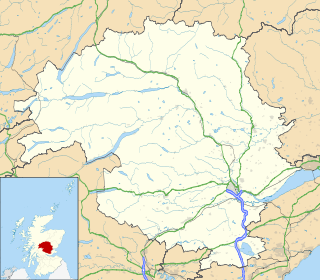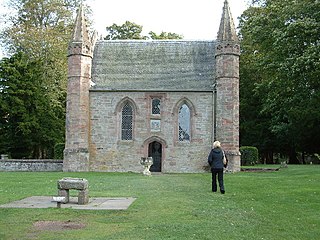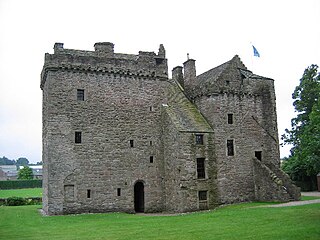This page is based on this
Wikipedia article Text is available under the
CC BY-SA 4.0 license; additional terms may apply.
Images, videos and audio are available under their respective licenses.

Kingussie is a small town in the Badenoch and Strathspey ward of the Highland council area of Scotland. Historically in Inverness-shire, it lies beside the A9 road, although the old route of the A9 serves as the town's main street which has been bypassed since 1979. Kingussie is 42 miles (68 km) south of Inverness, 12 miles (19 km) south of Aviemore, and 3 miles (4.8 km) north of Newtonmore.
John Ruthven, 3rd Earl of Gowrie, was a Scottish nobleman who died in mysterious circumstances, referred to as the "Gowrie Conspiracy", in which he and/or his brother Alexander were attempting to kill or kidnap King James VI of Scotland for unknown purposes. The king's retinue killed both brothers during the attack, and the king survived.

Huntingtower and Ruthvenfield, a village of Perthshire, Scotland, on the River Almond, some ten miles north-west of Perth.
Patrick Ruthven, 3rd Lord Ruthven, played an important part in the political intrigues of the 16th century Scotland. He succeeded to the lordship in December 1552. The Ruthven lordship encompassed the offices of Provost and Constable of Perth, and Sheriff of Strathearn.

The Clan Ruthven is a Lowland Scottish clan.
William Ruthven, 1st Earl of Gowrie, 4th Lord of Ruthven was a Scottish peer known for devising the Raid of Ruthven.
The Raid of Ruthven was a political conspiracy in Scotland which took place on 22 August 1582. It was composed of several Presbyterian nobles, led by William Ruthven, 1st Earl of Gowrie, who abducted King James VI of Scotland. The nobles intended to reform the government of Scotland and limit the influence of French and pro-Catholic policy, and to prevent or manage the return of Mary, Queen of Scots from England. Their short-lived rule is known as the "Ruthven" or "Gowrie Regime".

Ruthven is a former settlement in Badenoch, in the Highland council area, Scotland. It lies 0.5 miles (0.80 km) south of Kingussie, and 43 miles (69 km) to the south of Inverness, in the former county of Inverness-shire. The ruins of the 18th century Ruthven Barracks are nearby, on the site of the earlier Ruthven Castle. James Macpherson, the "translator" of the Ossian poems, was born here in 1736.
Huntingtower School is an independent, co-educational, non-denominational, day school and boarding school, located in the eastern Melbourne suburb of Mount Waverley, Victoria, Australia. The school currently caters for approximately 730 students from pre-prep to Year 12. Huntingtower is affiliated with the Association of Heads of Independent Schools of Australia (AHISA), the Association of Independent Schools of Victoria (AISV) and is a member of the Eastern Independent Schools of Melbourne (EISM). It is a member of the Victorian Ecumenical System of Schools (VESS).

Scone Abbey was a house of Augustinian canons located in Scone, Perthshire (Gowrie), Scotland. Dates given for the establishment of Scone Priory have ranged from 1114 A.D. to 1122 A.D. However, historians have long believed that Scone was before that time the center of the early medieval Christian cult of the Culdees. Very little is known about the Culdees but it is thought that a cult may have been worshiping at Scone from as early as 700 A.D. Archaeological surveys taken in 2007 suggest that Scone was a site of real significance even prior to 841 A.D., when Kenneth MacAlpin brought the Stone of Destiny, Scotland's most prized relic and coronation stone, to Scone.

Clan Murray is a Highland Scottish clan. The chief of the Clan Murray holds the title of Duke of Atholl. Their ancestors who established the family in Scotland in the 12th century were the Morays of Bothwell. In the 16th century descendants of the Morays of Bothwell, the Murrays of Tullibardine, secured the chiefship of the clan and were created Earls of Tullibardine in 1606. The first Earl of Tullibardine married the heiress to the Stewart earldom of Atholl and Atholl therefore became a Murray earldom in 1626. The Murray Earl of Atholl was created Marquess of Atholl in 1676 and in 1703 it became a dukedom. The marquess of Tullibardine title has continued as a subsidiary title, being bestowed on elder sons of the chief until they succeed him as Duke of Atholl.
Clan Charteris is a Lowland Scottish clan.

Clan Moncreiffe is a Scottish clan.

Captain James Stewart, Earl of Arran was created Earl of Arran by the young King James VI, who wrested the title from James Hamilton, 3rd Earl of Arran. He rose to become Lord Chancellor of Scotland and was eventually murdered in 1595.

Huntingtower is a 1928 British silent adventure film, made at Cricklewood Studios. It was directed by George Pearson and starred Harry Lauder, Vera Voronina and Patrick Aherne. It was based on the 1922 novel Huntingtower by John Buchan. The film was fairly successful on its release.
Events from the year 1600 in the Kingdom of Scotland











